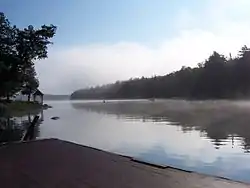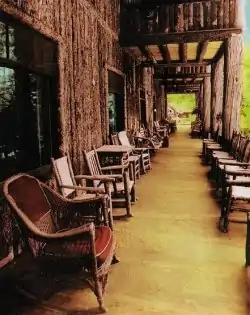Big Moose Lake
Big Moose Lake, at the head of the Moose River, is a large lake about five miles (8 km) north of Fourth Lake in the Adirondacks in upstate New York. The lake is within both Herkimer and Hamilton counties,[1] and covers portions of the towns of Webb and Long Lake. Located southwest of the lake is the hamlet of Big Moose.[2]
| Big Moose Lake | |
|---|---|
 Big Moose Lake, as seen from its outlet | |
 Big Moose Lake | |
| Location | Webb and Long Lake, New York |
| Coordinates | 43°49′01″N 74°51′17″W |
| Type | Glacial |
| Primary outflows | North Branch Moose River |
| Basin countries | United States |
| Max. length | 3 mi (4.8 km) |
| Max. width | 1 mi (1.6 km) |
| Surface area | 1,242 acres (5.03 km2) |
| Average depth | 23 ft (7.0 m) |
| Max. depth | 85 ft (26 m) |
| Surface elevation | 1,824 ft (556 m) |
| Islands | 2 Echo Island |
| Settlements | Big Moose |
The lake's popularity derives from its remoteness, climate and beauty. It was the scene of the murder of Grace Brown in 1906 by her boyfriend. Alleged spectral sightings and subsequent media attention are said to have added to the allure.
Geography and climate
Located in the central-western part of the Adirondack region, Big Moose Lake covers 1,242 acres (5.03 km2) in surface area.[3] It is approximately three miles (4.8 km) long and almost one mile (1.6 km) wide, running in an east–west direction along its major axis.[4] The lake ranges in depth from 30 to 70 feet (9 to 21 m) in its deepest parts, with an average depth of 23 feet (7 m).[3]
In the summer, temperatures average from nightly lows of 45 °F (7 °C) to daytime highs of 75 °F (24 °C). In winter, the lake completely freezes over, and temperatures during the day reach an average high of 20 °F (−7 °C) and an average nightly low of 5 °F (−15 °C).[5]
Communities and recreation
Located southwest of the lake is the hamlet of Big Moose; other nearby communities include Eagle Bay, Inlet, Old Forge, and Thendara. With minimal road access, the lake's shore had not been developed very much. The population reaches a peak during the summer months, when vacationers arrive to stay at summer homes or local resorts.
The lake and its surrounding region are a popular spot for tourists year-round; boating, water-skiing, hiking and train rides from Thendara are available in the summer, and cross-country skiing and snowmobiling take place in the winter. It is home to the Big Moose Water Ski Club, whose members are residents of the region.
The 50,100-acre (203 km2) Pigeon Lake Wilderness Area lies just east of the lake.
Fishing
Big Moose lake also offers sport fishing opportunities for brook trout, lake trout, yellow perch, brown trout, and splake. There is a no state-owned boat launch; however, a commercial marina with a ramp is located on the south shore of West Bay.[6]
History

The lake's region was settled by European Americans primarily during the late 19th and early 20th centuries, as people gained access to the region by the first railroad constructed through the uninhabited Adirondack wilderness. Early trappers and hunters of the Adirondacks became guides there, eventually establishing permanent camps and hotels. Wealthy businessmen built large, private summer homes and their families lived here for the season, in the style of the Great Camps of the Vanderbilts and Morgans. Some of these lodges still exist.
The Big Moose Lake area is historically significant for its palisade architectural style, which used vertical half-log construction in lodges and cabins.[7]

Representation in culture
Big Moose Lake was the setting of An American Tragedy, a novel by Theodore Dreiser. He based his book on the historic events of the drowning murder of Grace Brown in the South Bay of Big Moose Lake in the early part of the 20th century. Her boyfriend Chester Gillette was convicted and executed for her murder. (Dreiser named the lake where the murder took place as Big Bittern Lake, after having visited Big Moose Lake.) and used it as a model for his fictional version.)
A Place in the Sun, a film starring Elizabeth Taylor, Shelley Winters, and Montgomery Clift, was an adaptation of the novel.
Claims of ghost sightings around the lake and associated with Grace Brown continue to be recorded. In 1996, the television series Unsolved Mysteries aired an episode that reenacted the events. It reported two such ghost sightings. On July 11, 2006 some residents organized a wreath-laying ceremony on South Bay to memorialize the centennial of Brown's murder. People participated from a small flotilla of watercraft.
Jennifer Donnelly based her historical novel, A Northern Light (2003), on this murder. She explores events from the perspective of a young girl working at the Glenmore (a lodge on the lake). Robert Tucker also set his novel, Sasquatch Camp (2013,) in this community.
Historic places
The following places are listed on the National Register of Historic Places:[8]
- Covewood Lodge (listed in 2004)
- Big Moose Community Chapel (listed in 2012)
Gallery
 Big Moose Lake viewed from Covewood Lodge
Big Moose Lake viewed from Covewood Lodge Postcard from 1930-1945 of Big Moose Lake
Postcard from 1930-1945 of Big Moose Lake Lake View Lodge, the first luxury hotel, built 1898 (1911 photo)[9]
Lake View Lodge, the first luxury hotel, built 1898 (1911 photo)[9]
References
- "Big Moose Lake". Geographic Names Information System. United States Geological Survey. Retrieved October 14, 2016.
- "Big Moose". Geographic Names Information System. United States Geological Survey. Retrieved October 14, 2016.
- "Big Moose Lake Contour Map" (PDF). New York State Department of Environmental Conservation. Retrieved October 14, 2016.
- Big Moose Lake, Adirondack Lakes Survey Corporation. 2005. Last accessed September 2, 2006.
- Average High/Low Temperatures for KGTB Weather Underground. Last accessed September 2, 2006.
- Sportsman's Connection (Firm) (January 1, 2004), Western Adirondacks New York fishing map guide: includes lakes & streams for the following counties: Herkimer, Jefferson, Lewis, Oneida, St. Lawrence., Sportsman's Connection, ISBN 1885010672, OCLC 61449593
- Barlow, Jane (Editor) (2004). Big Moose Lake in the Adirondacks. Syracuse, NY: Big Moose Lake History Project. pp. 22, 23. ISBN 0-8156-0774-1.CS1 maint: extra text: authors list (link)
- "National Register Information System". National Register of Historic Places. National Park Service. July 9, 2010.
- Barlow, Jane A. (Editor) (2004). Big Moose Lake in the Adirondacks The Story of the Lake, the Land, and the People. Syracuse, New York: Syracuse University Press. ISBN 0-8156-0774-1.CS1 maint: extra text: authors list (link)
Further reading
- Barlow, Jane A. (May 2004). Big Moose Lake in the Adirondacks: The Story of the Lake, the Land, and the People. Syracuse University Press. ISBN 0-8156-0799-7.
- Gilborn, Craig A.; Paul Malo (2000). Adirondack Camps: Homes Away from Home, 1850–1950. Syracuse University Press. ISBN 0-8156-0626-5.
External links
- People v. Gillette Court Transcript